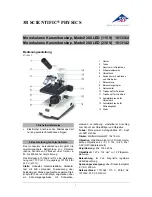
Operating Procedures:
Patterning
C O N F I D E N T I A L – FEI Limited Rights Data
5-47
Serial Patterning
All patterns defined on the screen are processed
consecutively
; milling / deposition is completed on one pattern
before moving to the next one. Serial patterning is always used with cleaning cross section milling. This is the
default patterning mode.
Parallel Patterning
All patterns defined on the screen are processed
concurrently
, one pass of the beam is completed on all patterns
before moving to the second pass. Parallel patterning is typically used to avoid a redeposition of material on the
adjacent areas.
With parallel patterning, the mill time is recalculated to include all the patterns that are shown in the image
window.
When a user switches to the Parallel mode, the following pattern properties in the group must necessarily be the
same:
Beam
,
Gas Type
and
Passes
. The first selected pattern determines these values for all other ones.
Other properties (
Application
,
Z size, Overlap
,
Saturation Sputter Rate
and
Refresh Time
) are also all set to those of the
first selected pattern to avoid confusion, even though they can theoretically remain unchanged. Restoring Serial
mode does not undo these changes; the properties remain as in the Parallel mode.
Progress area
Information updated as the milling progresses can be found here
(captions change according to a running process):
•
skip to a next pattern in order
•
Skip to a previous / next line
(available only with Cleaning Cross Section)
•
Total Time
– estimated total patterning time
•
Overall Progress
– related to the total patterning time of all patterns
•
Current Progress
/
CCS Line Progress
– related to the actual pattern in progress
Note
When patterning is paused in one display it is possible to start patterning in another one. Similarly when patterning
finishes there may still be a paused patterning in another display.
It is possible to acquire an image from the signals generated during patterning. All imaging parameters are dictated
by the patterning requirements. Much better images can be acquired by a Snapshot during patterning. In this case
patterning is paused, an image is grabbed and patterning resumes.
Note
If the magnification is too high, creating certain patterns can use too much memory needed for the control system to run.
The pattern corners become round and the edges become jagged. A good rule of thumb is to pick a magnification where
your pattern fills 35–50% of the screen.
Summary of Contents for Scios 2
Page 1: ...User Operation Manual Edition 1 Mar 2017 ...
Page 103: ...Alignments I Column Alignments C O N F I D E N T I A L FEI Limited Rights Data 4 19 ...
Page 110: ...Alignments 254 GIS Alignment option C O N F I D E N T I A L FEI Limited Rights Data 4 26 ...
Page 170: ...Operating Procedures Patterning C O N F I D E N T I A L FEI Limited Rights Data 5 60 ...
Page 178: ...Maintenance Refilling Water Bottle C O N F I D E N T I A L FEI Limited Rights Data 6 8 ...
















































